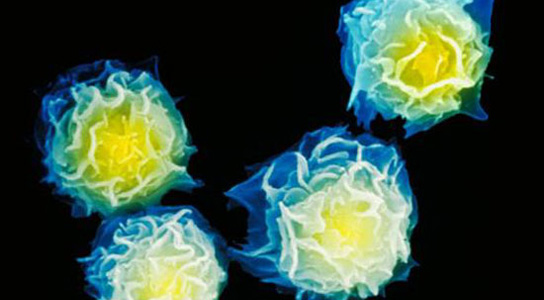Synthetic Molecule Destroys Key Allergy-Inducing Complexes
October 30, 2012

Scanning electron microscope image of mast cells.
A new synthetic molecule has been used to destroy the complexes that induce allergic responses, a discovery that could lead to highly potent, rapidly acting interventions for a host of acute allergic reactions.
The scientists published their findings in the journal Nature. The new inhibitor disarms IgE antibodies, which are pivotal players in acute allergies, by detaching the antibody from a molecule called FcR.
Many allergens can set off IgE antibodies, resulting in allergic reactions within seconds. This new inhibitor destroys the complex that tethers IgE to the mast cells responsible for the reaction. The first time potential allergens enter the body, allergen-specific IgE antibodies are produced, which stay around long after the initial allergen is cleared from the body. Most of the antibodies are caught by FcRs, which are IgE-specific receptors that are exposed on the surface of mast cells. These cells are then primed to react the next time the body encounters the allergen.
The dissociation of this IgE-FcR interaction has been the goal of allergy treatment for a while, since IgE-coated mast cells contain histamine, and re-encountering the allergen can be dangerous because it will trigger the release of inflammatory mediators, including histamine, that promote the allergic response.
The key to disabling the allergic response lies in the separation of IgE from FcRs, which has been difficult since their interaction is extremely stable. The new engineered protein inhibitor, called DARPin E2-79, strips IgE from mast the cell receptor in a matter of seconds.
DARPin E2-79 is part of a family of engineered inhibitors containing the protein-binding regions called ankryin repeats. After E2-79′s structure was solved, the information was used to model its interaction with the IgE-FcR pair. Then, sensitive biochemical techniques were used to detect the binding interactions between the molecules. The team was able to tease out the mechanism that the inhibitor uses to break the IgE-FcR bond.
Large macromolecules like E2-79 are expected to be less potent than smaller molecule inhibitors, which is why the fact that E2-79 works so well came as a surprise. The goal now is to find a smaller molecule with the same effect, which could be easier to manufacture and amenable to oral administration in patients.
No comments:
Post a Comment